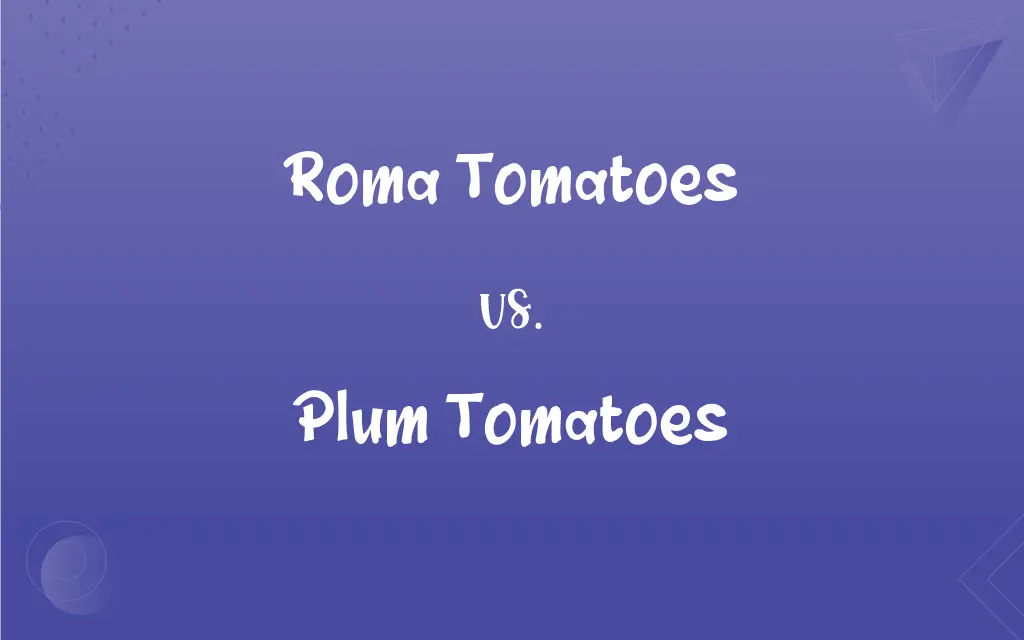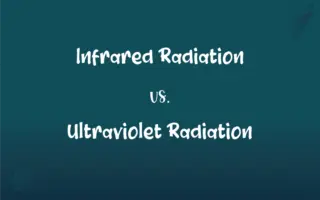Roma Tomatoes vs. Plum Tomatoes: What's the Difference?
Edited by Aimie Carlson || By Janet White || Published on June 29, 2024
Roma tomatoes are a type of plum tomato known for their egg shape, fewer seeds, and firmness, ideal for sauces and paste, while "plum tomato" can refer to any variety with a similar shape and use.

Key Differences
Roma tomatoes are a specific variety of plum tomatoes characterized by their elongated, egg-like shape. They are cultivated for their firm flesh and low moisture content, making them ideal for tomato sauces and paste. Plum tomatoes, including Roma tomatoes, are prized for their richer, sweeter flavor and fewer seeds, which contributes to their preference in culinary applications.
Plum tomatoes serve as a category that includes several varieties, such as Roma, San Marzano, and others, known for their similar plum or elongated shape. Roma tomatoes, as a subset of this category, are distinguished by their particular size, shape, and culinary uses. They are especially favored in Italian cuisine for making thick sauces and tomato paste due to their dense flesh and low water content.
The distinction between Roma tomatoes and other plum tomatoes lies in their specific variety traits. While all Roma tomatoes are plum tomatoes, not all plum tomatoes are Romas. Each variety within the plum tomato category has its unique flavor profile, texture, and culinary suitability, with Romas being one of the most popular due to their versatility and consistent quality.
In terms of cultivation and availability, Roma tomatoes are widely grown both commercially and in home gardens, thanks to their disease resistance and yield. They are easily identifiable in markets and stores by their signature shape and size. On the other hand, plum tomatoes can vary more widely in these aspects, depending on the specific variety and growing conditions.
When selecting between Roma tomatoes and other plum tomatoes, considerations might include the specific culinary application, desired texture, and flavor intensity. Roma tomatoes are a reliable choice for a variety of dishes, from sauces to salads, where their balanced sweetness and low seed content are advantageous. In contrast, other plum tomatoes might be selected for their particular nuances in flavor or texture, suitable for different culinary creations.
ADVERTISEMENT
Comparison Chart
Shape
Elongated, egg-like shape
Generally elongated but can vary among varieties
Seed Content
Fewer seeds
Seed content can vary, generally fewer seeds
Ideal Use
Sauces, paste, canning
Sauces, canning, fresh consumption
Moisture Content
Lower moisture content
Moisture content varies, generally lower
Popularity in Cuisine
Highly favored in Italian cuisine for sauces and pastes
Used broadly in various cuisines for similar uses
ADVERTISEMENT
Roma Tomatoes and Plum Tomatoes Definitions
Roma Tomatoes
Known for their low moisture content, Roma tomatoes are great for paste.
The Roma tomatoes reduced beautifully into a rich tomato paste.
Plum Tomatoes
Plum tomatoes often have fewer seeds and a firmer flesh than other varieties.
The firm flesh of plum tomatoes makes them ideal for roasting.
Roma Tomatoes
Roma tomatoes are elongated, firm tomatoes ideal for cooking.
I used Roma tomatoes to make a thick, flavorful spaghetti sauce.
Plum Tomatoes
Known for their sweet flavor, plum tomatoes enhance sauces and pastes.
The sauce made from plum tomatoes had a naturally sweet and rich taste.
Roma Tomatoes
Romas are a type of plum tomato, distinguished by their egg shape.
The grocery store had a fresh batch of egg-shaped Roma tomatoes today.
Plum Tomatoes
These tomatoes are a favorite for canning due to their shape and texture.
We canned dozens of jars of plum tomatoes for winter use.
Roma Tomatoes
Roma tomatoes are a garden favorite due to their robust flavor.
My garden's Roma tomatoes have ripened, promising a robust sauce.
Plum Tomatoes
Plum tomatoes are versatile, elongated tomatoes suitable for a variety of dishes.
I diced some plum tomatoes for the salsa, and their flavor was perfect.
Roma Tomatoes
Roma tomatoes have fewer seeds, making them less watery.
I prefer Roma tomatoes in my salads because they're not as watery.
Plum Tomatoes
Plum tomatoes include varieties like Roma and San Marzano.
For this recipe, you can use any type of plum tomatoes, like Roma or San Marzano.
FAQs
What makes Roma tomatoes a popular choice for sauces?
Their dense flesh, fewer seeds, and balanced sweetness make Roma tomatoes a popular choice for creating thick, flavorful sauces.
How do plum tomatoes differ from Roma tomatoes?
Plum tomatoes refer to any tomato variety with an elongated shape suitable for sauces and canning, including Romas, but Roma tomatoes are a specific type of plum tomato.
Can Roma tomatoes be eaten raw?
Yes, Roma tomatoes can be eaten raw and are often used in salads and sandwiches for their robust flavor and firm texture.
Are Roma tomatoes better for cooking than other tomato varieties?
Roma tomatoes are especially good for cooking due to their low moisture content and firm texture, which makes them ideal for sauces and pastes.
What are Roma tomatoes?
Roma tomatoes are a plum tomato variety known for their egg shape, firm flesh, and low moisture content, making them ideal for sauces and paste.
Are there different types of plum tomatoes besides Roma?
Yes, there are several types of plum tomatoes, including San Marzano and others, each with unique characteristics.
Can I use plum tomatoes instead of Roma tomatoes in recipes?
Yes, plum tomatoes can generally be substituted for Roma tomatoes in recipes, though the flavor and texture may vary slightly.
How should Roma tomatoes be stored for maximum freshness?
Store Roma tomatoes at room temperature away from direct sunlight to preserve their flavor and freshness.
What dishes are plum tomatoes best suited for?
Plum tomatoes are best suited for sauces, pastes, canning, and fresh consumption in salads and sandwiches.
Are Roma tomatoes genetically modified?
Roma tomatoes are not genetically modified; they are a naturally occurring variety selected for their desirable culinary traits.
Do Roma and plum tomatoes have the same nutritional value?
Yes, both Roma and plum tomatoes share similar nutritional profiles, being low in calories and rich in vitamins C and K, potassium, and antioxidants.
What is the best way to process Roma tomatoes for sauce?
The best way to process Roma tomatoes for sauce is by blanching, peeling, and then simmering them to reduce their moisture content and concentrate their flavor.
Why are plum tomatoes often used in canned products?
Plum tomatoes are used in canned products because their firm flesh and lower water content hold up well during the canning process, retaining flavor and texture.
How do I choose the best Roma tomatoes at the store?
Look for Roma tomatoes that are firm, vibrant in color, and free from blemishes or soft spots.
Can I freeze Roma tomatoes for later use?
Yes, Roma tomatoes can be frozen, especially useful for making sauces or stews later.
What is the origin of Roma tomatoes?
Roma tomatoes were developed to meet the need for a tomato variety that was well-suited for processing and canning, with their origins traced back to agricultural breeding programs.
Can plum tomatoes be grown in a home garden?
Yes, plum tomatoes, including Roma varieties, can be grown in a home garden and are popular among home gardeners for their yield and ease of growth.
How do Roma tomatoes contribute to Italian cuisine?
Roma tomatoes are a staple in Italian cuisine, used extensively in sauces, pastes, and pizzas for their authentic flavor and texture.
What is the peak season for Roma and plum tomatoes?
The peak season for Roma and plum tomatoes is late summer, though they are often available year-round in many regions.
How do Roma tomatoes compare to cherry tomatoes in flavor?
Roma tomatoes have a more concentrated, less acidic flavor compared to the sweeter, more tangy taste of cherry tomatoes.
About Author
Written by
Janet WhiteJanet White has been an esteemed writer and blogger for Difference Wiki. Holding a Master's degree in Science and Medical Journalism from the prestigious Boston University, she has consistently demonstrated her expertise and passion for her field. When she's not immersed in her work, Janet relishes her time exercising, delving into a good book, and cherishing moments with friends and family.
Edited by
Aimie CarlsonAimie Carlson, holding a master's degree in English literature, is a fervent English language enthusiast. She lends her writing talents to Difference Wiki, a prominent website that specializes in comparisons, offering readers insightful analyses that both captivate and inform.







































































